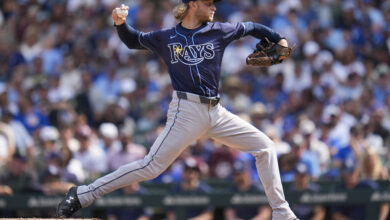
Draft Will Provide Clues to Cubs’ Competitive Timeline, Even if Team Says Otherwise
The 2022 MLB Draft is just a day away and with it comes the first landmark in a series of events that will help us discern the Cubs’ plans for the short-term future of the team. While it’s not entirely accurate to say drafting 17-year-old Cam Collier — who may well be gone by No. 7 anyway — would signal a desire to kick the competitive can two more years down the road, selecting Georgia Tech catcher Kevin Parada might make it easier to go for it next year.
That’s not how VP of scouting Dan Katrovitz is looking at the situation, at least not publicly, though it seems like an impossible task to entirely separate draft strategy from MLB-level planning. So just like Jed Hoyer employs his exec-speak to say a whole lot while saying absolutely nothing, one of his top lieutenants played it close to the vest when addressing the media recently.
“It’s too imprecise to try to time the selection of a draft pick with a team’s competitive window,” Kantrovitz told Patrick Mooney and other reporters. “So if it ends up being a ‘toolsier’ high school player that we draft that requires a little bit more time, then we have the infrastructure to handle it. And if it ends up being a college player that is projected to get there a little quicker, then I think we’ll be equally happy.”
There’s more at play here that we’ve got time to get into in one piece, but I think it bears noting that the Cubs targeted polished college hitters who could advance quickly when they were ready to start winning during the last rebuild. And when you consider that most of the prospects they acquired in last year’s trades are optimistically looking at 2024 debuts, you can see how getting a potential fast-track player would be desirable.
Parada is particularly interesting because he’s a catcher, which could become an area of need for the organization very shortly if Willson Contreras is traded. That offense will be hard to replace, but having a guy who hit 26 homers with a 1.162 OPS last season could help. Besides, Yan Gomes still has one more guaranteed year with the club holding an option for another, and P.J. Higgins is no slouch.
Drafting Parada would add further credence to the notion that ’24 is the target, and could even indicate that they’ll use next season as sort of an analog to 2015. Of course, Parada is being projected in the top five by many and may not be an option. The potential for a quick rise also exists with shortstops Brooks Lee and Zach Neto, both of whom possess the kind of contact bat the Cubs have craved of late.
If, however, we see Rick Sutcliffe at the podium calling the names of Collier, Termarr Johnson, or Elijah Green, the plan might simply be to backfill the lower levels of the minors as current top prospects advance. That’s much more exciting for those who follow the minor leagues religiously because it’ll likely be four years or more before any of those players could reasonably be expected to come up.
For the sake of context, I think we should also take stock of some prospects who aren’t among the organization’s elite when it comes to rankings. Matt Mervis is a lefty slugger who could wind up holding down first base or DH for a while, then they’ve got Jake Slaughter as a utility infielder who has more than a little pop as well. It’s not just about having top-100 prospects playing roles, it’s about getting solid production from homegrown players and letting that determine the course of action in free agency.
That wouldn’t mean Hoyer is going to try to keep rolling over payroll money for several more seasons, mind you, just that things might be quiet in Chicago just a little longer. In the end, we may only be talking about a difference of a season or so, with the spending ramping up either next season or the year after. And by that I mean meaningfully spending to create a winner, since they’re going to have to sign some players this offseason just to field a roster.
Rather than drafting for a window, Katrovitz stressed that they want to find players who the Cubs believe fit their system. There’s also some of that “best available player” mentality from the previous quote involved.
“We put a lot of weight on that because we have to really make sure that we understand the person and what motivates them and how they think,” Kantrovitz said. “That’s also an inexact science. But I think the more that we can put into it, the more that we can be confident we know who we’re drafting.”
What would be really interesting to see is whether the Cubs can go underslot with a college bat at No. 7, then turn around and pick up a player who dropped due to bonus demands or injury or whatever. It really does appear as though their player evaluation process has improved tremendously over the last 2-3 years and it’ll be fun to see if we can read any tea leaves this weekend.

